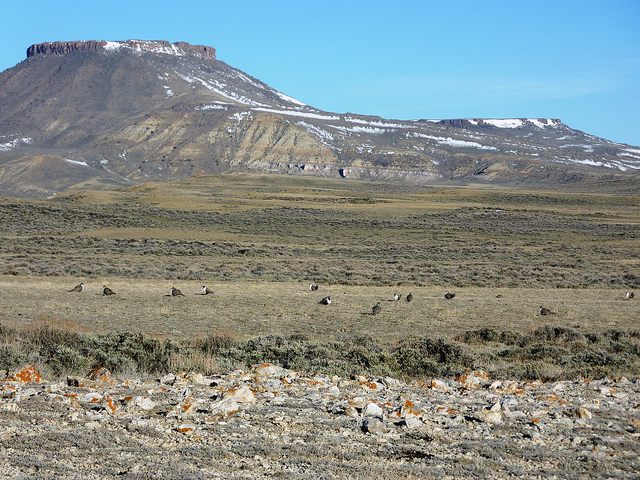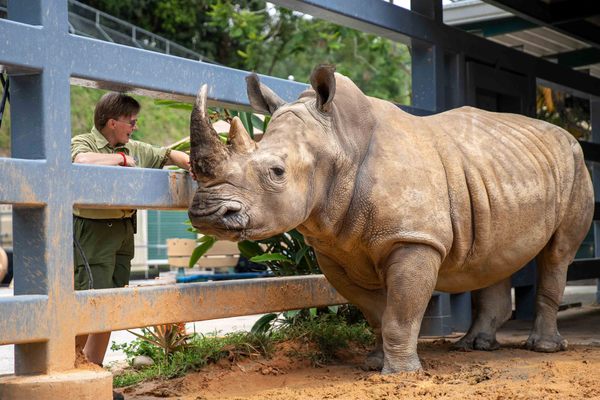The Fate of This Funny-Looking Bird May Be The Future of Conservation
 A Greater Sage Grouse. (Photo: Bob Wick/BLM/flickr)
A Greater Sage Grouse. (Photo: Bob Wick/BLM/flickr)
Last week, when the Obama administration decided it would try and protect the sage grouse without listing it as endangered, many environmentalists were furious. But in a surprising twist, many of bird’s most ardent advocates, the people who have been trying to save it for years, were thrilled.
“I’ve been involved with the Endangered Species Act since it’s inception. I lobbied for it when I was in high school and college. And celebrated it when it was passed into law the year I graduated. It’s the best conservation law on the planet,” says Brian Rutledge, who managed major zoos for thirty years before becoming Vice President of the National Audubon Society, and a leading voice in sage grouse conservation. “And yet it was designed and best used to encourage planning and conservation to avoid placing a species on the list. Sometimes ending up on that list is the last thing you want. That’s the point of no return.”
Rutledge is not alone in his thinking. Ever since 2010, when the Fish & Wildlife Service decided that the greater sage grouse deserved some protection from the ranchers, energy developers, coal miners, and oil drillers who were encroaching on its sagebrush habitat, something unexpected happened. Public officials, government agencies, conservationists, and various other stakeholders from 10 Western states banded together to save the bird themselves.
Their efforts, some say, are historic. In the report by Fish & Wildlife, the sage grouse population was shown to have dropped 90 percent over the last century. Aiming to restore a vast, interconnected ecosystem that spans 11 states, public officials and conservationists have cut back trees where hawks and ravens dwell. They’ve planted new brush where sage grouse nest and forage. And in May, the Bureau of Land Management announced a long-awaited plan to protect the sage grouse from going extinct by regulating miners, energy developers, and ranchers in 10 states from working in sagebrush wilderness.
Rarely do ranchers and energy developers cross the aisle for one another, never mind government agencies like the BLM and Fish & Wildlife, which are known for eyeing each other warily. Yet the specter of a federal listing was enough to motivate them into an almost unholy communion over a plucky, ground-dwelling bird. Now, five years and $200 million later, their state-led efforts to protect a species without a federal listing may just be a model for future conservation efforts.
 A sage grouse habitat in south central Wyoming. (Photo: USFWS Mountain-Prairie/flickr)
A sage grouse habitat in south central Wyoming. (Photo: USFWS Mountain-Prairie/flickr)
This notion of keeping conservation as local as possible has roots in earlier battles. When the northern spotted owl was listed as endangered in the 1990s, it was a huge win for environmentalists, and a loss for the lumber industry in the Northwest, which was slapped with major restrictions. As the forests thickened and the owls came back, nearby towns that had once depended on logging atrophied, or emptied out all together.
Many took it as a lesson. “You can’t do conservation to the exclusion of humans that share the landscape. They are a reality,” Rutledge says. “For many they are an unhappy reality, but they are a reality nonetheless. They have needs and rights and interests, and not just self-interest.”
Former Governor of Wyoming, Dave Fraudenthal, was also in this camp. So when he began sitting down with stakeholders to discuss the future of the sage grouse, in the early 2000s, he put local economics and community engagement at the heart of the discussions.
“He realized that the listing of this bird was potentially severely damaging to the human economy of Wyoming,” remembers Rutledge, who was there in those early meetings. “So he decided to engage stakeholders in a collaborative process and come up with a plan that everyone could live with, including the bird.”
 A sign on Highway 28 between Farson and Seedskadee National Wildlife Refuge in Wyoming. (Photo: USFWS Mountain-Prairie/Wikimedia Commons CC BY 2.0)
A sign on Highway 28 between Farson and Seedskadee National Wildlife Refuge in Wyoming. (Photo: USFWS Mountain-Prairie/Wikimedia Commons CC BY 2.0)
As a leading voice of the National Audubon Society, Rutledge says that saving the bird has always been his main motivation. But being a self-proclaimed “paranoid” rancher who “feels like the world is against him,” Rutledge possesses a kind of double vision. He may be a devoted conservationist, but he’s also a savvy political pragmatist whose efforts are animated by the belief that the best stewards of the land are often the locals who live on it.
But not everyone agrees. To many activists and scientists, the notion that states are better at managing their land than the feds sounds more like political ideology than evidence-based conservation. They worry that the future of the sage grouse isn’t in the hands of local people, but in the pockets of powerful industries like coal, gas, and wind.
Researchers like Rob Spaul, a raptor ecologist at Boise State University who is familiar with the situation, says that government agencies have been “punting this issue for a while” because these industry ties are so powerful.
The political dogfight has also played out in the scientific community. In March, as the Western Association of Fish and Wildlife Agencies prepared a report that would help determine whether the bird should be listed or not, a handful of scientists wrote a letter to Sally Jewell, Secretary of the U.S. Department of the Interior, and Tom Vilsack, Secretary of the U.S. Department of Agriculture, imploring them to “review the best available science and make recommendations for conserving greater sage-grouse.” They also expressed concern “that federal agencies appear to be abandoning science-based conservation measures reflected in the published scientific literature.”
 Greater sage grouse along the banks of Green River in Seedskadee National Wildlife Refuge, Wyoming. (Photo: USFWS Mountain-Prairie/flickr)
Greater sage grouse along the banks of Green River in Seedskadee National Wildlife Refuge, Wyoming. (Photo: USFWS Mountain-Prairie/flickr)
Many of these scientists are highly respected in their fields and have made important contributions to the body of sage grouse research. But at least one of the signees, Jeff Beck, an associate professor of wildlife habitat restoration ecology at University of Wyoming, felt he had signed the letter in the name of good science–only to find out later that it was being used to further various political and activist agendas.
Beck wouldn’t comment further, except to say that he’s in favor of the sage grouse not being listed, and despite the political turmoil, thinks the localized effort appears to have legs. “People who normally wouldn’t sit at a table together have come together and motivated behind this because there is so much at stake. When you look at how large an area these people all come from, it’s really unprecedented.”
Beck believes that if the sage grouse is to survive, government agencies, public officials, stakeholders, and conservationists will have to follow through on the efforts they’ve begun.
 A sage grouse in Cokeville Meadows, Wyoming. (Photo: K. Theule/USFWS/flickr)
A sage grouse in Cokeville Meadows, Wyoming. (Photo: K. Theule/USFWS/flickr)
As for Rutledge, he is optimistic yet determined, knowing the task before him is nothing short of undoing 150 years of destructive development. “We need to learn how to grow sagebrush, how to restore the grasses underneath it, and restore the fragmentation that was caused by unnecessary roads and powerlines,” he says. “We need to learn to leave a smaller footprint.”
If local communities are to save this “forest in exquisite miniature,” as Mark Twain once described the shrubby plant, “they’ll have to get on their bellies in the sagebrush to see what he meant.”


















Follow us on Twitter to get the latest on the world's hidden wonders.
Like us on Facebook to get the latest on the world's hidden wonders.
Follow us on Twitter Like us on Facebook